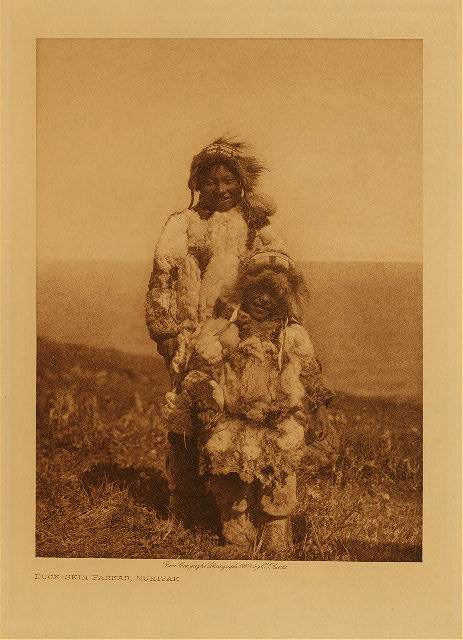
Marriage, children, & divorce
Edward S. Curtis married Clara S. Phillips in 1892 and they had four children together. His photography work took him away from home for long periods of time. Due to his long absences and the financial drain on the business, Clara divorced him in 1916 and gained full custody of their children. Edward S. Curtis’ life changed dramatically and he moved into the Rainier Club in Seattle. He paid for room and board by taking portraits of its wealthy members. At the time of the divorce, many negatives were lost because both Clara and Edward S. Curtis destroyed them rather than see the other person own them.
In the 1920s, Curtis worked briefly in the motion picture business. He worked on Tarzan movies and in 1923 worked on The Ten Commandments with director Cecil B. DeMille. After a few years in the business he went back to working on The North American Indian project, though on a much smaller scale. He took his daughter, Florence, with him into the field.
Edward S. Curtis’ life: The dream crumbles
Though J.P. Morgan and his son, J.P. Morgan, Jr., financed half of the $1.5 million eventual publication costs, Curtis lost money to the point that he borrowed against his own copyrights. He ended up giving the remaining copies to Morgan. Charles E. Lauriat Company bought the copyrights in 1935 for $1,000, plus a percentage of future royalties. A complete set was donated to the University of Oregon and this was Curtis’ own set that he had kept hidden from Morgan.

Curtis ended up living the last 30 years of his life near his daughter, Beth Magnuson, in California. She financed a trip for her father so that he could document the Eskimo people. She also paid for an assistant named Stuart Eastwood. Beth went with him on this trip. They hit a bad storm almost immediately and ended up stuck high and dry on a sandbar for two days. There is film footage showing them stuck on the sandbar.
They went on to Nunivak Island and Curtis was impressed by the people there saying “he never knew a happier and more thoroughly honest and self-reliant people”. He said that he had “found a place where no missionary has worked.” Sadly, about ten years after his arrival, Swedish missionaries established themselves and destroyed much of the culture.
When he returned from his trip to the North, he was arrested for failure to pay alimony to his wife. He had to point out to the judge that he had no money since he wasn’t paid for the project. Curtis wept in front of the court upon disclosing his financial situation. The judge threw the case out.
Charting a different course
When the Great Depression hit, there was little interest in an expensive publication such as his. In 1932, Curtis moved to Colorado and had a complete physical breakdown. He spent time with his son doing gold mining. He invented a device to extract gold dust, the Curtis Counter Current Concentrator. Curtis started to write about gold mining.
In 1948, a retired librarian in Seattle, Harriet Leitch, contacted Curtis. The Seattle Historical Society sought more information from him about a donated partial set of The North American Indian. Though there seemed to be little interest from the public about him in his last years, Harriet was able to record much of his life story from their correspondence.

Edward S. Curtis’ life ends
Edward S. Curtis’ life ended in 1952. He is survived by his grandchild, Gary Curtis, and three great-grandchildren. Gary, age 88, lives on the Olympic Peninsula in Washington State. He plans to be around for at least three more years so that he can celebrate the 150th anniversary of Edward S. Curtis’ birth in 2018. Representatives from several institutions owning some of Curtis’ work recently met to discuss what they would like to show at the sesquicentennial event.
Photos by Edward S. Curtis in this article are from the following source: http://curtis.library.northwestern.edu/index.html
Posts in this series:
Edward S. Curtis Fever in Bend, Oregon
Edward S. Curtis Photo Techniques & Artistic Movements Pt. 2
Edward S. Curtis History – Childhood to Businessman Pt. 3
Edward S. Curtis’ Mission – A History (continued) Pt. 4
Edward S. Curtis’ life of twists & turns Pt. 5
Edward S. Curtis’ Film – In the Land of the Head-Hunters – Pt. 6
Controversy surrounding Edward Curtis & documentary – Pt. 7
I love these historical pictures, sad and inspiring at once
Yes, they are. It was difficult to decide which to feature in this series.
Pingback: Edward S. Curtis History - Childhood to Businessman Pt. 3 - bend branches
Pingback: Edward S. Curtis Fever in Bend, Oregon - bend branches
Pingback: Edward S. Curtis Photo Techniques & Artistic Movements Pt. 2 - bend branches